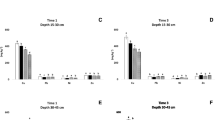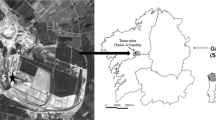Abstract
Purpose
Soil metal pollution is a widespread problem around the world and remediation of these soils is difficult. The objective of this study was to investigate the effect of two different strategies on the chemical fractions of metals in a soil of a depleted copper mine: (1) amending with a mixture of a technosol made of wastes and biochar and (2) amending combined with planting vegetation (Brassica juncea).
Materials and methods
A 3-month greenhouse experiment was carried out to evaluate the effects of organic amendments and vegetation on the metal fractionation of Cu, Ni, Pb and Zn in a mine soil of the depleted copper mine at Touro (Spain). We compared the influence of organic amendments alone (technosol + biochar) and combined with mustard plants (Brassica juncea L.).
Results and discussion
The results showed that amending with a technosol made of wastes promoted plant growth (from 0.7 to 2.9 g of biomass produced) and reduced the CaCl2-extractable metal concentration in soil, reduced the mobility factor of Cu from 18.3 to 1.6, Ni from 47.5 to 2.3 and Pb from 17.9 to 2.1, and also reduced the concentration of metals in the mobile soil fractions. It was not possible to grow up Brassica juncea plants in the untreated settling pond soil due to the extremely degraded conditions of that soil. However, the application of the used technosol increased the Pb and Zn pseudototal concentrations in the amended soils.
Conclusions
We conclude that the combination of amending with wastes and planting B. juncea provides little additional benefit for remediating a metal-polluted soil compared with incorporation of wastes alone.

Similar content being viewed by others
References
Ahnstrom ZS, Parker DR (1999) Development and assessment of a sequential extraction procedure for the fractionation of soil cadmium. Soil Sci Soc Am J 63:1650–1658
Ali H, Khan E, Sajad MA (2013) Phytoremediation of heavy metals-Concepts and applications. Chemosphere 91:869–881
Arenas-Lago D, Andrade ML, Lago-Vila M, Rodríguez-Seijo A, Vega FA (2014) Sequential extraction of heavy metals in soils from a copper mine: Distribution in geochemical fractions. Geoderma 230–231:108–118
Asensio V, Vega FA, Andrade ML, Covelo EF (2013a) Technosols made of wastes to improve physico-chemical characteristics of a copper mine soil. Pedosphere 23:1–239
Asensio V, Covelo EF, Kandeler E (2013b) Soil management of copper mine tailing soils - Sludge amendment and tree vegetation could improve biological soil quality. Sci Total Environ 456–457:82–90
Asensio V, Vega FA, Singh BR, Covelo EF (2013c) Effects of tree vegetation and waste amendments on the fractionation of Cr, Cu, Ni, Pb and Zn in polluted mine soils. Sci Total Environ 443:446–453
Beesley L, Moreno-Jiménez E, Gomez-Eyles JL, Harris E, Robinson B, Sizmur T (2011) A review of biochars’ potential role in the remediation, revegetation and restoration of contaminated soils. Environ Pollut 159:3269–3282
Bolan NS, Adriano DC, Naidu R (2003) Role of phosphorus in (im)mobilization and bioavailability of heavy metals in the soil-plant system. Rev Environ Contam Toxicol 177:1–44
Bolan N, Kunhikrishnan A, Thangarajan R, Kumpiene J, Park J, Makino T, Kirkham MB, Scheckel K (2014) Remediation of heavy metal(loid)s contaminated soils—to mobilize or to immobilize? J Hazard Mater 266:141–166
Camps Arbestain M, Madinabeitia Z, Anza Hortalà M, Macías-García F, Virgel S, Macías F (2008) Extractability and leachability of heavy metals in Technosols prepared from mixtures of unconsolidated wastes. Waste Manag 28:2653–2666
Clark GJ, Dodgshun N, Sale PWG, Tang C (2007) Changes in chemical and biological properties of a sodic clay subsoil with addition of organic amendments. Soil Biol Biochem 39:2806–2817
Do Nascimento CW, Amarasiriwardena D, Xing B (2006) Comparison of natural organic acids and synthetic chelates at enhancing phytoextraction of metals from a multi-metal contaminated soil. Environ Pollut 140:114–123
Fellet G, Marmiroli M, Marchiol L (2014) Elements uptake by metal accumulator species grown on mine tailings amended with three types of biochar. Sci Total Environ 468–469:598–608
Food and Agriculture Organization (FAO) (2006) World Reference Base for Soil Resources. IUSS, ISRIC, FAO, Rome
Gondar D, Bernal MP (2009) Copper binding by olive mill solid waste and its organic matter fractions. Geoderma 149:272–279
Greipsson S (2011) Phytoremediation. Nat Educ Knowl 3:7
Herath I, Kumarathilaka P, Navaratne A, Rajakaruna N, Vithanage M (2014) Immobilization and phytotoxicity reduction of heavy metals in serpentine soil using biochar. J Soils Sediments 15(1):126–138
Houba VJG, Temminghoff EJM, Gaikhorst GA, Van Vark W (2000) Soil analysis procedures using 0.01 M calcium chloride as extraction reagent. Commun Soil Sci Plant Anal 31:1299–1396
Jelusic M, Lestan D (2014) Effect of EDTA washing of metal polluted garden soils. Part I: Toxicity hazards and impact on soil properties. Sci Total Environ 475:132–141
Karami N, Clemente R, Moreno-Jiménez E, Lepp NW, Beesley L (2011) Efficiency of green waste compost and biochar soil amendments for reducing lead and copper mobility and uptake to ryegrass. J Hazard Mater 191:41–148
Khurana MPS, Kansal BD (2014) Effect of farm yard manure on chemical fractionation of cadmium and its bio-availability to maize crop grown on sewage irrigated coarse textured soil. J Environ Biol 35:431–437
Kumar V, Chopra AK (2014) Accumulation and translocation of metals in soil and different parts of French bean (Phaseolus vulgaris L.) amended with sewage sludge. Bull Environ Contam Toxicol 92:103–108
Kumpiene J, Lagerkvist A, Maurice C (2008) Stabilization of As, Cr, Cu, Pb and Zn in soil using amendments – A review. Waste Manag 28:215–225
Liang H-M, Lin T-H, Chiou J-M, Yeh K-C (2009) Model evaluation of the phytoextraction potential of heavy metal hyperaccumulators and non-hyperaccumulators. Environ Pollut 157:1945–1952
Lu A, Zhang S, Shan X-Q (2005) Time effect on the fractionation of heavy metals in soils. Geoderma 125(3–4):225–234
Ma L, Rao X, Lu P, Huang S, Chen X, Xu Z, Xie J (2015) Acid-tolerant plant species screened for rehabilitating acid mine drainage sites. J Soils Sediments 15(5):1104–1112
Macías F, Calvo de Anta R (2009) Niveles genéricos de referencia de metales pesados y otros elementos traza en los suelos de Galicia. Xunta de Galicia, Spain
Mench M, Schwitzguebel J-P, Schroeder P, Bert V, Gawronski S, Gupta S (2009) Assessment of successful experiments and limitations of phytotechnologies: contaminant uptake, detoxification and sequestration, and consequences for food safety. Environ Sci Pollut Res 16:876–900
Merdy P, Gharbi LT, Lucas Y (2009) Pb, Cu and Cr interactions with soil: sorption experiments and modelling. Colloids Surf Physicochem Eng Asp 347:192–199
Mingorance MD, Rossini Oliva S, Valdés B, Pina Gata FJ, Leidi EO, Guzmán I, Peña A (2014) Stabilized municipal sewage sludge addition to improve properties of an acid mine soil for plant growth. J Soils Sediments 14(4):703–715
Pardo T, Clemente R, Epelde L, Garbisu C, Bernal MP (2014) Evaluation of the phytostabilisation efficiency in a trace elements contaminated soil using soil health indicators. J Hazard Mater 268:68–76
Park JH, Lamb D, Paneerselvam P, Choppala G, Bolan N, Chung J-W (2011) Role of organic amendments on enhanced bioremediation of heavy metal (loid) contaminated soils. J Hazard Mater 185:549–574
Perez-de-Mora A, Burgos P, Madejon E, Cabrera F, Jaeckel P, Schloter M (2006) Microbial community structure and function in a soil contaminated by heavy metals: effects of plant growth and different amendments. Soil Biol Biochem 38:327–341
Pérez-Esteban J, Escolástico C, Moliner A, Masaguer A, Ruiz-Fernández J (2013) Phytostabilization of metals in mine soils using Brassica juncea in combination with organic amendments. Plant Soil 377:97–109
Porta J (1986) Técnicas y experimentos en Edafología. Collegi Oficial D’Enginyers Agronoms de Catalunya, Barcelona, Spain
Puig CG, Álvarez-Iglesias L, Reigosa MJ, Pedrol N (2013) Eucalyptus globulus leaves Incorporated as green manure for weed control in maize. Weed Sci 61:154–161
Quartacci MF, Argilla A, Baker AJM, Navari-Izzo F (2006) Phytoextraction of metals from a multiply contaminated soil by Indian mustard. Chemosphere 63:918–925
Quevauiller PH, Rauret G, Griepink B (1993) Conclusions of the workshop: single and sequential extraction in sediments and soils. Int J Environ Anal Chem 57:135–150
Rodríguez-Vila A, Covelo EF, Forján R, Asensio V (2014) Phytoremediating a copper mine soil with Brassica juncea L., compost and biochar. Environ Sci Pollut Res 21(19):11293–11304
Rodríguez-Vila A, Covelo EF, Forján R, Asensio V (2015) Recovering a copper mine soil using organic amendments and phytomanagement with Brassica juncea L. J Environ Manag 147:73–80
Saier MH, Trevors JT (2010) Phytoremediation. Water Air Soil Pollut 205:61–63
Salbu B, Krekling T, Oughton DH (1998) Characterisation of radioactive particles in the environment †. Analyst 123:843–849
Santos ES, Abreu MM, Macías F, de Varennes A (2015) Chemical quality of leachates and enzymatic activities in Technosols with gossan and sulfide wastes from the São Domingos mine. J Soils Sediments. doi:10.1007/s11368-015-1068-8
Sarma H (2011) Metal hyperaccumulation in plants: a review focusing on phytoremediation technology. J Environ Sci Technol 4:118–138
Simon L (2005) Stabilization of metals in acidic mine spoil with amendments and red fescue (Festuca rubra L.) growth. Environ Geochem Health 27:289–300
Singh A, Prasad SM (2011) Reduction of heavy metal load in food chain: technology assessment. Rev Environ Sci Biotechnol 10:199–214
Sohi SP, Krull E, Lopez-Capel E, Bol R (2010) Chapter 2—A Review of biochar and its use and function in soil. Adv Agron 105:47–82
Tandy S, Healey JR, Nason MA, Williamson JC, Jones DL (2009) Remediation of metal polluted mine soil with compost: co-composting versus incorporation. Environ Pollut 157:690–697
Tessier A, Campbell PGC, Blsson M (1979) Sequential extraction procedure for the speciation of particulate trace metals. Anal Chem 51:844–851
USDA (1998) Soil Quality Indicators : pH. 2
Van Aken B (2009) Transgenic plants for enhanced phytoremediation of toxic explosives. Curr Opin Biotechnol 20:231–236
Yang S, Cao J, Hu W, Zhang X, Duan C (2013) An evaluation of the effectiveness of novel industrial by-products and organic wastes on heavy metal immobilization in Pb-Zn mine tailings. Environ Sci Process Impacts 15:2059–2067
Acknowledgments
This study was supported by the Spanish Ministry of Education through project CGL2009-07843.
Compliance with Ethical Standards
The authors declare no potential conflicts of interest. The present research did not involve human participants and/or animals.
Author information
Authors and Affiliations
Corresponding author
Additional information
Responsible editor: Xilong Wang
Rights and permissions
About this article
Cite this article
Rodríguez-Vila, A., Asensio, V., Forján, R. et al. Assessing the influence of technosol and biochar amendments combined with Brassica juncea L. on the fractionation of Cu, Ni, Pb and Zn in a polluted mine soil. J Soils Sediments 16, 339–348 (2016). https://doi.org/10.1007/s11368-015-1222-3
Received:
Accepted:
Published:
Issue Date:
DOI: https://doi.org/10.1007/s11368-015-1222-3




